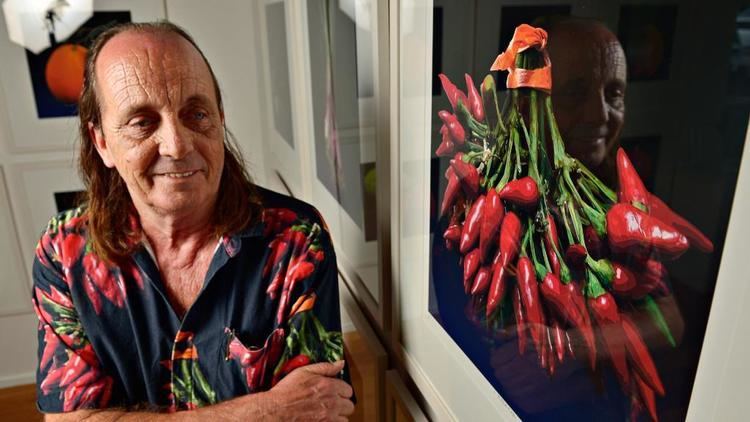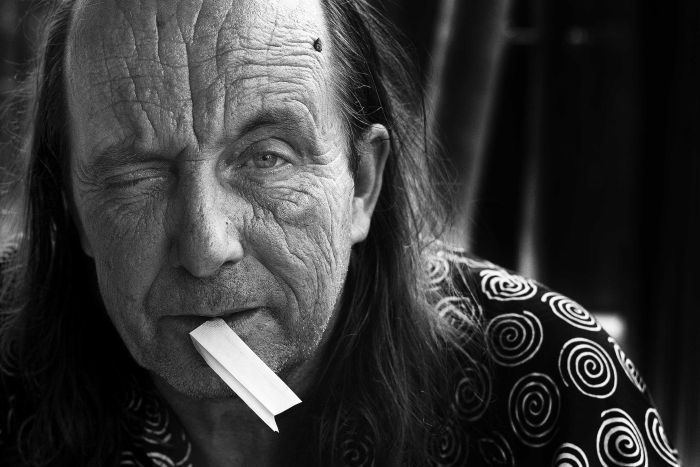Name Chips Mackinolty | ||
"The Doves of Vucciria" - A portrait of Australian Artist Chips Mackinolty (Palermo, Sicily)
Chips Mackinolty (born 1954, Morwell, Victoria, Australia) was involved in the campaigns against the war in Vietnam by producing posters. He was a key figure in the radical poster movement and was introduced to screenprinting in Goulburn Street, Sydney.
Contents
- The Doves of Vucciria A portrait of Australian Artist Chips Mackinolty Palermo Sicily
- Wealth of the Land
- Early life
- Public service roles
- Journalist
- Exhibitions
- References

Wealth of the Land
Early life

During the 1970s posters became an art form artists using the cheap posters as a political tool. The Earthworks Poster Collective, established in 1971, was the most active and well-known of these groups. Earthworks operated from the Sydney University Art Workshop, commonly known as the Tin Sheds, finally demolished in 2007.
In 1978 Mackinolty designed a poster to commemorate Prime Minister Robert Menzies death, to reflect a workingclass view on the Prime Minister, and the 'Pig Iron Bob' nickname that was given to him during the Dalfram dispute of 1938.
Mackinolty used sharp, flat colours and increasingly professional techniques to produce posters such as "For the man who said life wasn't meant to be easy - make life impossible". The poster is a multi-imaged send-up of former Australian Prime Minister Malcolm Fraser. It was posted up at night around Sydney, helping to politicise a generation.
Public service roles
With the dissolution of Earthworks Poster Collective in 1980, Mackinolty moved first to Townsville, North Queensland, as a community arts officer, and then to the Northern Territory of Australia. He worked as an art adviser to Aboriginal art centres in Katherine (Mimi Aboriginal Arts and Crafts, 1981–1985) and Mutitjulu (Maruku Arts, 1985). From then until 1990 he worked at the Northern Land Council in Darwin as a journalist, designer and field officer. He produced a number of posters in that period under the name Jalak Graphics, although most were printed at Redback Graphics in Wollongong and Sydney. Many used Aboriginal languages in their text.
During the 1990s Mackinolty worked with others from Darwin under the banner of Green Ant Research Arts and Publishing. Mackinolty also accepted assignments from the CLP government including the euthanasia education program. He also acted as a go-between, liaising between the CLP government and the Jawoyn traditional owners of Katherine.
Mackinolty was employed as an advisor to the Northern Territory Labor Government 2002-2009, under various ministers, then quit to work for the Aboriginal Medical Services Alliance Northern Territory (AMSANT) as a policy worker, a position he held until 2013 when he left for an extended period in Europe and the Middle East.
Journalist
As well as graphic design, Mackinolty worked as a correspondent for newspapers including the Sydney Morning Herald, The Age, The Australian and The Bulletin. Mackinolty has been an occasional correspondent for Crikey, particularly it's arts section. He has also contributed articles to The Monthly magazine.
Exhibitions
Work in the 1990s included a controversial exhibition of posters with colleague Therese Ritchie If you see this exhibition you'll know we have been murdered which was attacked by the then Country Liberal Party government (1998). Along with Therese Ritchie, in 2000 he was a joint winner with Bede Tungatalum, of the Fremantle Print Award. In 2010, again with Therese Ritchie, he held a retrospective at Charles Darwin University, Not Dead Yet. In the same year he won the 4th Togart Award worth $15,000, for Contemporary Visual Art. He continues to exhibit art in the Northern Territory, interstate and internationally. His 2016 exhibition The Wealth of the Land was launched in Palermo, Sicily.
His work is held in National Gallery of Australia; National Museum of Australia; Artbank; Art Gallery of NSW; National Gallery of Victoria; Museum and Art Gallery of the Northern Territory; Charles Darwin University, Northern Territory; Australian War Memorial; Launceston Art Gallery; Art Gallery of South Australia; Mitchell collection, NSW State Library; National Library of Australia; University of Adelaide; Monash University, Melbourne; Museum of Contemporary Art, Sydney; Queensland Art Gallery; Griffith University, Queensland; Powerhouse Museum, Sydney; Museum of Contemporary Art, Sydney; Australian Centre for the Moving Image, Melbourne; Australian Institute for Aboriginal and Torres Strait Islander Studies, Canberra, Dictionary of Sydney, http://www.dictionaryofsydney.org; Art Gallery of Ballarat; Mooreland Art Gallery; National Library of New Zealand, Médiathèque de silos, Chaumont (France), Museum of Modern Art (NY, USA) and private collections.
